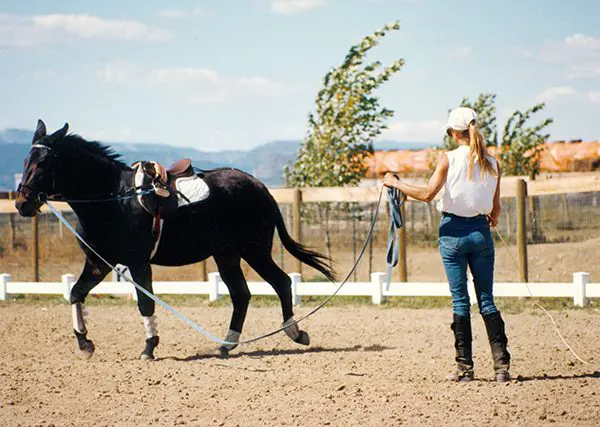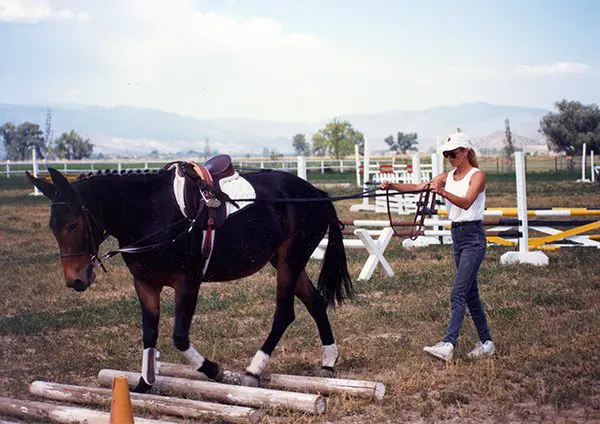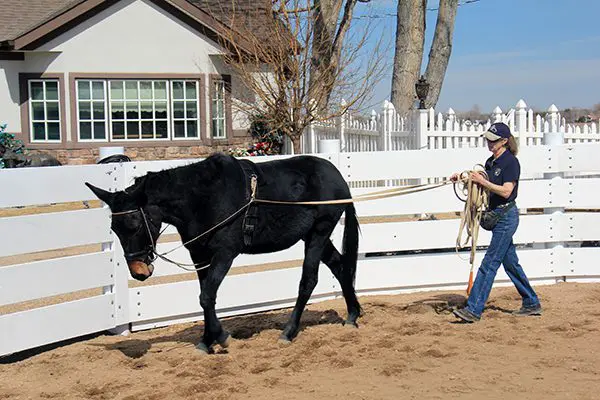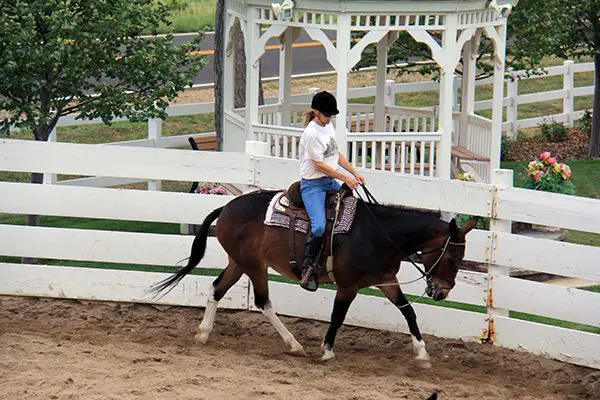MULE CROSSING: Good Basic Training Includes Common Sense, Part 4
By Meredith Hodges
In Part3, your equine was properly strengthened and balanced in good posture during the more passive exercises in leading training over obstacles. Now, in the fourth and final part of this article, you and your equine will head to the round pen and learn how to balance correctly on the circle at the faster gaits. You’ll also learn the more advanced and quicker moves that are required under saddle and in harness.
 Only after you have adequately completed lead line flatwork and obstacle training is your equine truly ready to move on to the round pen and begin lunging and learning to balance on a circle at the more active gaits. At this stage, he should be complying willingly, walking with the lead rope slung over his neck and with his head at your shoulder. By now, his core muscles should be properly conditioned and strong enough to support his skeletal system during more active use and more complicated movements. Note: The equine that has not had this prior lead line balance and good posture training will have difficulty in the round pen because he has not learned to stay erect and bend his body through the rib cage when on arcs and circles.
Only after you have adequately completed lead line flatwork and obstacle training is your equine truly ready to move on to the round pen and begin lunging and learning to balance on a circle at the more active gaits. At this stage, he should be complying willingly, walking with the lead rope slung over his neck and with his head at your shoulder. By now, his core muscles should be properly conditioned and strong enough to support his skeletal system during more active use and more complicated movements. Note: The equine that has not had this prior lead line balance and good posture training will have difficulty in the round pen because he has not learned to stay erect and bend his body through the rib cage when on arcs and circles.
When you are lunging your equine, stand close to the center of the round pen, focus your eyes on the lower part of your equine’s haunches, and then give the verbal command to “Walk on.” Let your eyes and whip follow his haunches while you stand in the center of the round pen. If you want him to stop, say “Whoa,” and then move your eyes and body sideways so that you are more in front of him. Then raise your head and eyes to meet his eyes. If you want him to do a reverse, give the verbal command to “Reverse,” move your body sideways and crack the whip smartly in front of him. You should now be almost directly in front of him, looking him straight in the eye. It is the movement of your body that will make the difference between the halt and the turn. Notice how these subtle differences in your body affect what he does. If you practice these movements correctly and consistently, you will begin to see an improvement in your own body language and in your equine’s response. It doesn’t matter what anyone else does or says; you go right ahead and take the time you need to work out each maneuver with your equine. Accuracy is preferred over speed.
Lunging involves a lot more than just running your equine around in a circle. It affords you a tremendous opportunity to see the affect your body language has on your equine’s reactions. Lunging also helps you to understand how you can fine-tune the communication between the two of you while developing balanced, cadenced and rhythmic gaits in your animal. So start slow and don’t let things go beyond what you can easily control.
With the use of the “Elbow Pull” (instructions on how to make an “Elbow Pull” are given in the Equus Revisited DVD), your equine will begin to build muscle over a correct postural frame. This is much better than letting him develop muscle out of good posture, and then having to go back later and break down established muscle that is out of frame and causing problems. The “Elbow Pull” is not in any way abusive. It is, in fact, a “self-correcting” support, designed to simply suggest to an equine that he stay in good posture. If he stays in good posture, he feels nothing uncomfortable. But if he gets out of good posture, it puts a humane but firm pressure on his poll, his bit, behind his forearms and over his back. This is not unlike the grandmother who insisted that, to assure good posture, you walk with a book on your head. It may have sounded silly at first, but as you got older, you were happy you did it because it taught you good posture that eventually became a healthy and habitual way of moving. The “Elbow Pull” serves the same purpose for your equine and provides support when he cannot consistently hold good posture—he learns a healthy and habitual way of moving.
 Before your equine learns to balance with a rider, he must first build muscle so he can sustain his own balance on the circle before carrying a rider. This is also true if you want your animal to learn to lunge on a lunge line. An equine that has not had enough time in the round pen establishing strength, coordination and balance on the circle will have difficulty on the lunge line, because even the slightest pressure on the line will pull him off-balance. Loss of balance will cause stress and even panic in your equine, which can result in him pulling the lunge line right out of your hands and running off. This is not disobedience but rather, fear caused by a loss of balance so do not punish him for this reaction. The animal that has had strength built on the circle before lunging and riding will not exhibit these undesirable behaviors, which are often misinterpreted as disobedience.
Before your equine learns to balance with a rider, he must first build muscle so he can sustain his own balance on the circle before carrying a rider. This is also true if you want your animal to learn to lunge on a lunge line. An equine that has not had enough time in the round pen establishing strength, coordination and balance on the circle will have difficulty on the lunge line, because even the slightest pressure on the line will pull him off-balance. Loss of balance will cause stress and even panic in your equine, which can result in him pulling the lunge line right out of your hands and running off. This is not disobedience but rather, fear caused by a loss of balance so do not punish him for this reaction. The animal that has had strength built on the circle before lunging and riding will not exhibit these undesirable behaviors, which are often misinterpreted as disobedience.
Lunging will begin to develop hard muscle over the core muscles and tendons you have already spent so many months strengthening. It will further enhance your equine’s ability to perform and stay balanced in action. As this becomes his true way of going, you will notice that even his play patterns begin to change dramatically. Be sure to be consistent with your verbal commands during these beginning stages, as they set the stage for better communication going forward.
After your equine has learned verbal commands while lunging, your next step is to train him to be equally responsive to verbal commands in conjunction with the drivelines. This is done first in the round pen, and then in an open arena, (which will introduce him to a larger space where he will need to become even more responsive to your rein cues).
 I have found that, in most cases, the larger the animal, the more docile the personality, which seems to be a general rule of thumb. I have also learned that, if a donkey or mule has a tendency to bolt and run, it’s because they don’t necessarily agree with what you are trying to do or how you are trying to do it. Even though horses usually comply fairly easily, it is important to remember that any disobedience on the part of any equine is ALWAYS the handler’s fault. Regardless of the personality type of an equine, he will always have an honest response to any stimulus. If you ask in the right way, you will get the desired response.
I have found that, in most cases, the larger the animal, the more docile the personality, which seems to be a general rule of thumb. I have also learned that, if a donkey or mule has a tendency to bolt and run, it’s because they don’t necessarily agree with what you are trying to do or how you are trying to do it. Even though horses usually comply fairly easily, it is important to remember that any disobedience on the part of any equine is ALWAYS the handler’s fault. Regardless of the personality type of an equine, he will always have an honest response to any stimulus. If you ask in the right way, you will get the desired response.
If your equine wants to bolt when you ground-drive from behind, walk beside him and gradually lengthen the distance, one inch at a time, until he has accepted the drivelines correctly—no matter how long it takes. But don’t work on lessons more than 20 to 40 minutes every other day, and make sure he gets his crimped oats reward for “Whoa” and “Back.” I give a lot of “Back” commands while ground driving close to an animal, and I repeat “Back” frequently at every increased or decreased distance behind him. Keep things at a very slow walk until you feel relaxation through the drivelines (there should be no hint of pulling). Stay calm and deliberate and go slowly—be willing to take all the time in the world, if necessary. Whether you are just beginning training, or are already working under saddle, while you and your equine are going to and from the work areas, and during any ground interaction, always review the lessons in showmanship covered in DVDs #1, #8 and #9 of my series, Training Mules & Donkeys before moving on to any new exercises. This will help your equine to really and truly bond with you on a very personal level. If you have multiple equines, be sure to treat every equine as your very favorite whenever you interact with them.
Certain personality types such as slow learners, over-achievers or sensitive individuals do take longer to come around, but when treated with plenty of patience, kindness, trust and respect, they usually do. These personality types may not necessarily be suitable for driving, but they can be quite suitable for under saddle. In fact, once they do come around, the more “difficult” equines, especially those that have previously been neglected or abused, often bond more strongly with you and look to you as their “protector.” They are grateful for your patience and kindness. These are sometimes the ones who will end up having more “spirit” and thus, more athletic tendencies and ability.
Because I have dealt with many animals that were high strung, I have learned that they require tremendous patience, but I also know that they can come around. You might just need to back up and do things even more slowly and more meticulously than you ever thought you would need to, but if you do, you should see some positive results. If you lower your expectations for a while and try to have more fun with the basics, chances are that your equine will, too.
Always make sure you work in areas that are adequately and safely fenced so that, if your equine bolts, you can more easily catch him again. If he bolts, DO NOT, under any circumstances, hold onto the reins, lead or drivelines. Just let go of the lead or drivelines if you are on the ground, and let the reins loose if you are in the saddle. Whether he is on the lead line, in the drivelines or under saddle, when your equine realizes that you aren’t going to play “tug-o-war,” that he will get a reward for staying put, and that it is a waste of his energy to keep running, he will bolt less and less until the unwanted behavior has stopped.
 When ground driving, you should not worry about the whip while in the round pen, as the walls will help guide your animal in maintaining the correct position. What you really need to do is keep even contact on both lines (reins) when going in a straight line (or, when in the round pen, on the circle). To get your equine to begin stepping laterally, slightly tighten the outside driveline while maintaining contact on the inside driveline, so that he cannot complete the turn. Stay directly behind his haunches and urge him forward. This will cause him to begin to step sideways, with his face to the wall. Take only a couple of steps this way, and then slowly straighten him out again—you can build-in more lateral steps as he begins to understand what you want. Be sure to reward him with crimped oats every time you halt.
When ground driving, you should not worry about the whip while in the round pen, as the walls will help guide your animal in maintaining the correct position. What you really need to do is keep even contact on both lines (reins) when going in a straight line (or, when in the round pen, on the circle). To get your equine to begin stepping laterally, slightly tighten the outside driveline while maintaining contact on the inside driveline, so that he cannot complete the turn. Stay directly behind his haunches and urge him forward. This will cause him to begin to step sideways, with his face to the wall. Take only a couple of steps this way, and then slowly straighten him out again—you can build-in more lateral steps as he begins to understand what you want. Be sure to reward him with crimped oats every time you halt.
Once you begin ground driving in the open, you can then carry your whip in your right hand. Feed the line into your right hand under your third, fourth and fifth fingers, and then up between your thumb and index finger. The whip handle will be held in the palm and also come up between your thumb and index finger. Tilt this hand to tap the right and left sides of your animal’s body. The left-hand driveline is fed over the index finger and held by the thumb, and then falls down through the palm. To set the bend for the leg yield (opposite from the way your equine will be tracking), shorten the inside rein and hold it steady. Not too much of a bend—you just want to be able to see his eye on that side. Then squeeze and release the directing (right-hand) driveline to indicate that you want him to move in the direction you are squeezing and releasing. Be sure to give plenty of release between pulls so he doesn’t go too far sideways at first. This should be a leg yield action and not a “side pass.” The “side pass” will come later, as he better understands what you want. If he doesn’t follow your leading rein, you can encourage him to move over by tapping him gently on his opposite side. It can be very awkward at first, but with time and patience, these movements (both his and yours) will continue to improve.
Only after he is light and responsive to all commands in the round pen and he ground-drives well in the open arena, should you mount him and begin riding in the round pen. When he is light and responsive in the bridle in the round pen, you can then ride in the open, but continue to work in the open arena on perfecting his technique and his responsiveness in the snaffle bit.
You need to be willing to spend the time to teach these things slowly and in an order that will make sense to your equine, so he is not faced with learning too much too quickly. As you have probably already experienced, when you hurry through this process, he may be able to do certain movements, but he will not be responsive to your cues. Unresponsiveness is a sure sign that there has just not been enough time for the lessons he is learning to become his habitual way of responding.
 If an animal is trained with sequential, resistance-free training techniques and is given adequate time on groundwork training (a minimum of one year on the lead line and a second year on lunging and ground driving), he will warm up to other people more easily and will be more “sensible” than those animals that are not trained this way. Each new owner should take the time to review these techniques with newly acquired equines, just to create their own personal relationship with that animal and dispel the negativity of any prior relationships the animal might have had. Spending time doing simple basic groundwork training before actually riding allows your relationship with your equine to develop in a safe and healthy way. It will teach both you (the handler) and your equine how to communicate clearly and effectively. The exercises described in this article will condition your equine’s body so he can more easily carry a rider (whether the rider is balanced or not), and help your equine to be more capable of executing whatever demands the future may hold.
If an animal is trained with sequential, resistance-free training techniques and is given adequate time on groundwork training (a minimum of one year on the lead line and a second year on lunging and ground driving), he will warm up to other people more easily and will be more “sensible” than those animals that are not trained this way. Each new owner should take the time to review these techniques with newly acquired equines, just to create their own personal relationship with that animal and dispel the negativity of any prior relationships the animal might have had. Spending time doing simple basic groundwork training before actually riding allows your relationship with your equine to develop in a safe and healthy way. It will teach both you (the handler) and your equine how to communicate clearly and effectively. The exercises described in this article will condition your equine’s body so he can more easily carry a rider (whether the rider is balanced or not), and help your equine to be more capable of executing whatever demands the future may hold.
Remember that patience, kindness, respect and consideration from you will yield the same qualities in return from your equine. When you take the time to cultivate a good relationship with him, you will find that you have a much safer and happier riding and driving companion.
To learn more about Meredith Hodges and her comprehensive all-breed equine training program, visit LuckyThreeRanch.com, MEREDITH HODGES PUBLIC FIGURE Facebook page, or call 1-800-816-7566. Check out her children’s website at JasperTheMule.com. Also, find Meredith on Pinterest, Instagram, MeWe, YouTube and Twitter..
Covered in TRAINING MULES & DONKEY: A LOGICAL APPROACH TO TRAINING, TRAINING WITHOUT RESISTANCE, EQUUS REVISITED and A GUIDE TO RAISING & SHOWING MULES at www.luckythreeranchstore.com.
© 2015, 2016, 2020, 2024 Lucky Three Ranch, Inc. All Rights Reserved.




